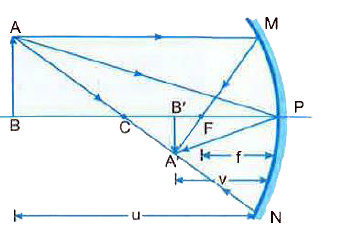(a) Using the necessary ray diagram, derive the mirror formula for a concave mirror.
(b) In the magnified image of a measuring scale (with equidistant markings) lying along the principal axis of a concave mirror, the markings are not equidistant. Explain.
Text Solution
The correct Answer is:a
(a) Figure, shows ray diagram explaining formation of a real image of a linear object AB placed in front of a concave mirror MPN of focal length f Since aperture of mirror is small, hence MP be considered to be a straight line.
Let us consider right angled triangles A.B.F and MPF, which are similar triangles. Therefore,
But as PM= AB, hence, we have
....(i)
Again triangles APB and A.PB. are also similar triangles and we have

Comparing (i) and (ii), we get
As per sign convention followed: BP = -u, B.P =-v, and FP =-f Therefore, we get
or
Dividing throughout by uvf, we get
, which is the requisite mirror formula.
(b) Magnification of a mirror is given as:
As different markings of a measuring scale lying along the principal axis of a concave mirror are at different positions (i.e., u is different for them), we get magnified images of these marks but magnification differs from one mark to another. As a result, the markings in image are not equidistant.
|
Topper's Solved these Questions
- EXAMINATION PAPER 2020 (SOLVED)BOOK - U-LIKE SERIESCHAPTER - EXAMINATION PAPER 2020 (SOLVED)EXERCISE - SECTION D
6 Videos
- EXAMINATION PAPER 2020 (SOLVED)BOOK - U-LIKE SERIESCHAPTER - EXAMINATION PAPER 2020 (SOLVED)EXERCISE - SECTION B
9 Videos
- ELECTROSTATIC POTENTIAL AND CAPACITANCE BOOK - U-LIKE SERIESCHAPTER - ELECTROSTATIC POTENTIAL AND CAPACITANCE EXERCISE - SELF ASSESSMENT TEST
1 Videos
- MAGNETISM AND MATTERBOOK - U-LIKE SERIESCHAPTER - MAGNETISM AND MATTEREXERCISE - SELF ASSESSMENT TEST (Section D)
1 Videos
Similar Questions
Knowledge Check
When a ray of light travelling parallel to the principal axis of a concave mirror strikes at the polished surface of mirror, the reflected ray
Ais sent back along the same directionBpasses through the principal focus of mirrorCpasses through the centre of curvature of mirrorDpasses through the pole of mirror
Ray diagram for Concave Mirror
View SolutionIs the virtual image formed by a concave mirror always magnified ?
View SolutionDraw ray diagram to shown the principal focus of a (i) concave mirror, (ii) convex mirror.
View SolutionA ray of light moving along the principal axis is falling on a concave mirror. In which direction is it reflected ?
View SolutionDraw a ray diagram to show image formation when the concave mirror produces a real inverted and magnified image of the object
View SolutionDraw a concave mirror and a convex mirror and mark the reflecting surfaces on both.
View SolutionDraw ray diagrams showing the image formation by a concave mirror when an object is placed at centre of curvature of the mirror
View Solution
